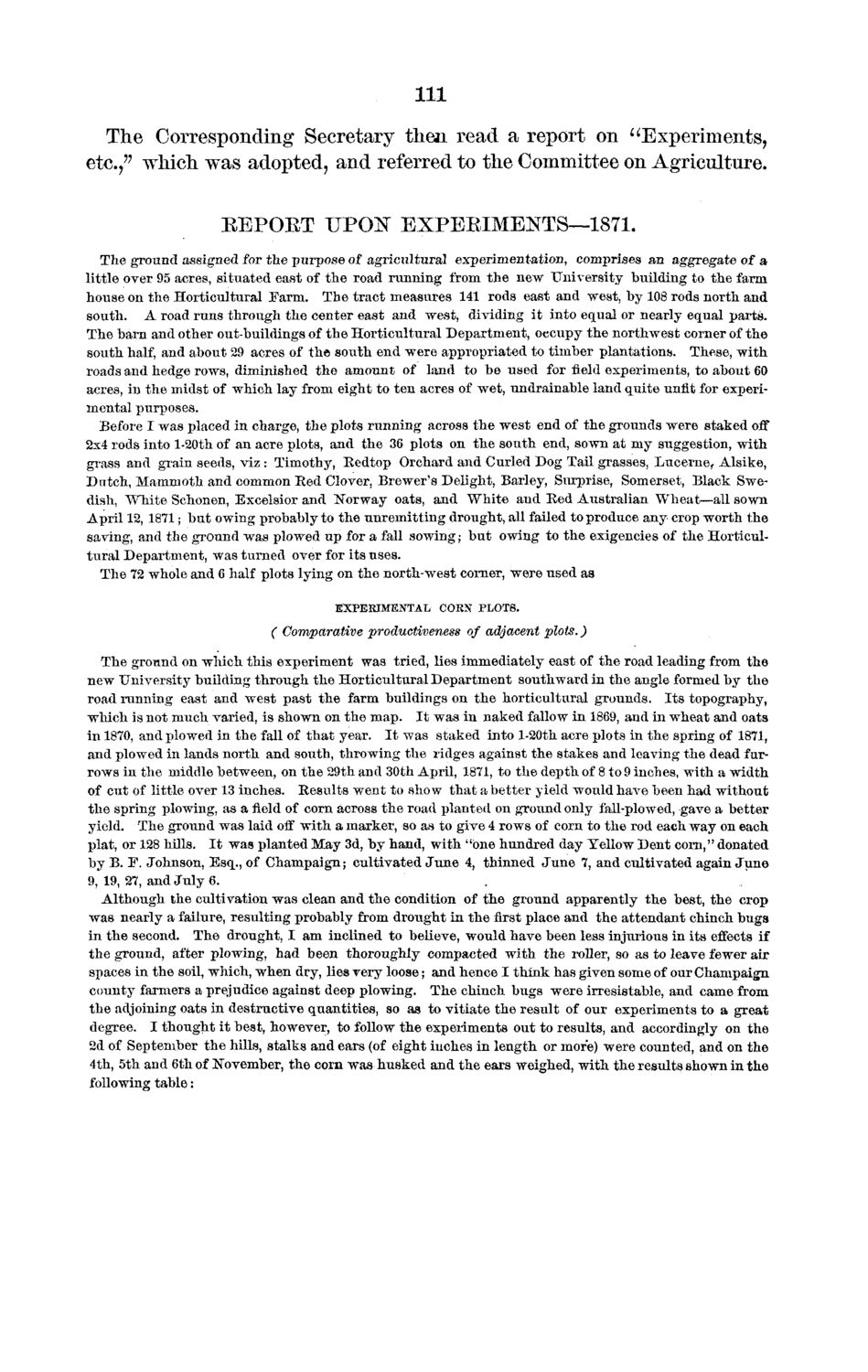| |
| |
Caption: Board of Trustees Minutes - 1872
This is a reduced-resolution page image for fast online browsing.

EXTRACTED TEXT FROM PAGE:
Ill The Corresponding Secretary then read a report on "Experiments, etc./' which was adopted, and referred to the Committee on Agriculture. EEPOET UPO^T EXPEBIMENTS—1871. The ground assigned for the purpose of agricultural experimentation, comprises an aggregate of a little over 95 acres, situated east of the road running from the new "University building to the farm house on the Horticultural Farm. The tract measures 141 rods east and west, by 108 rods north and south. A road runs through the center east and west, dividing it into equal or nearly equal parts. The barn and other out-buildings of the Horticultural Department, occupy the northwest corner of the south half, and about 29 acres of the south end were appropriated to timber plantations. These, with roads and hedge rows, diminished the amount of land to be used for field experiments, to about 60 acres, in the midst of which lay from eight to ten acres of wet, undrainable land quite unfit for experimental purposes. Before I was placed in charge, the plots running across the west end of the grounds were staked off 2x4 rods into l-20th of an acre plots, and the 36 plots on the south end, sown at my suggestion, with grass and grain seeds, viz : Timothy, Redtop Orchard and Curled Dog Tail grasses, Lucerne, Alsike, Dutch, Mammoth and common Red Clover, Brewer's Delight, Barley, Surprise, Somerset, Black Swedish, White Schonen, Excelsior and Norway oats, and White and Red Australian Wheat—all sown April 12, 1871; but owing probably to the unremitting drought, all failed to produce any crop worth the saving, and the ground was plowed up for a fall sowing; but owing to the exigencies of the Horticultural Department, was turned over for its uses. The 72 whole and 6 half plots lying on the north-west corner, were used as EXPERIMENTAL CORN PLOTS. C Comparative productiveness of adjacent plots.) The ground on which this experiment was tried, lies immediately east of the road leading from the new University building through the Horticultural Department southward in the angle formed by the road running east and west past the farm buildings on the horticultural grounds. I t s topography, which is not much varied, is shown on the map. I t was in naked fallow in 1869, and in wheat and oats in 1870, and plowed in the fall of that year. I t was staked into l-20th acre plots in the spring of 1871, and plowed in lands north and south, throwing the ridges against the stakes and leaving the dead furrows in the middle between, on the 29th and 30th April, 1871, to the depth of 8 to 9 inches, with a width of cut of little over 13 inches. Results went to show that a better yield would have been had without the spring plowing, as a field of corn across the road planted on ground only fall-plowed, gave a better yield. The ground was laid off with a marker, so as to give 4 rows of corn to the rod each way on each plat, or 128 hills. I t was planted May 3d, by hand, with "one hundred day Yellow Dent corn," donated by B. F. Johnson, Esq., of Champaign; cultivated June 4, thinned June 7, and cultivated again June 9, 19, 27, and July 6. . Although the cultivation was clean and the condition of the ground apparently the best, the crop was nearly a failure, resulting probably from drought in the first place and the attendant chinch bugs in the second. The drought, I am inclined to believe, would have been less injurious in its effects if the ground, after plowing, had been thoroughly compacted with the roller, so as to leave fewer air spaces in the soil, which, when dry, lies very loose; and hence I think has given some of our Champaign county farmers a prejudice against deep plowing. The chinch bugs were irresistable, and came from the adjoining oats in destructive quantities, so as to vitiate the result of our experiments to a great degree. I thought it best, however, to follow the experiments out to results, and accordingly on the 2d of September the hills, stalks and ears (of eight inches in length or more) were counted, and on the 4th, 5th and 6th of November, the corn was husked and the ears weighed, with the results shown in the following table:
| |